Court Report: Human Rights, Human Services, and the Law Analysis
VerifiedAdded on 2022/10/18
|11
|2766
|4
Report
AI Summary
This report analyzes the treatment of offenders with mental disorders in court proceedings, focusing on human rights and the criminal justice system. The author observed a case involving an offender with a mental disorder, examining the provision of legal representation, the court's approach to sentencing, and the societal perceptions of the offender. The report reviews literature on mental health, criminal law, and the characteristics of offenders with mental disorders. It evaluates the fairness of the proceedings, considering both legal and societal justice, and the role of human services. The author concludes that the criminal justice system needs to improve its approach to offenders with mental disorders, advocating for greater awareness, mental health services within the system, and the protection of basic human rights. The report also includes a questionnaire completed during the court visit.
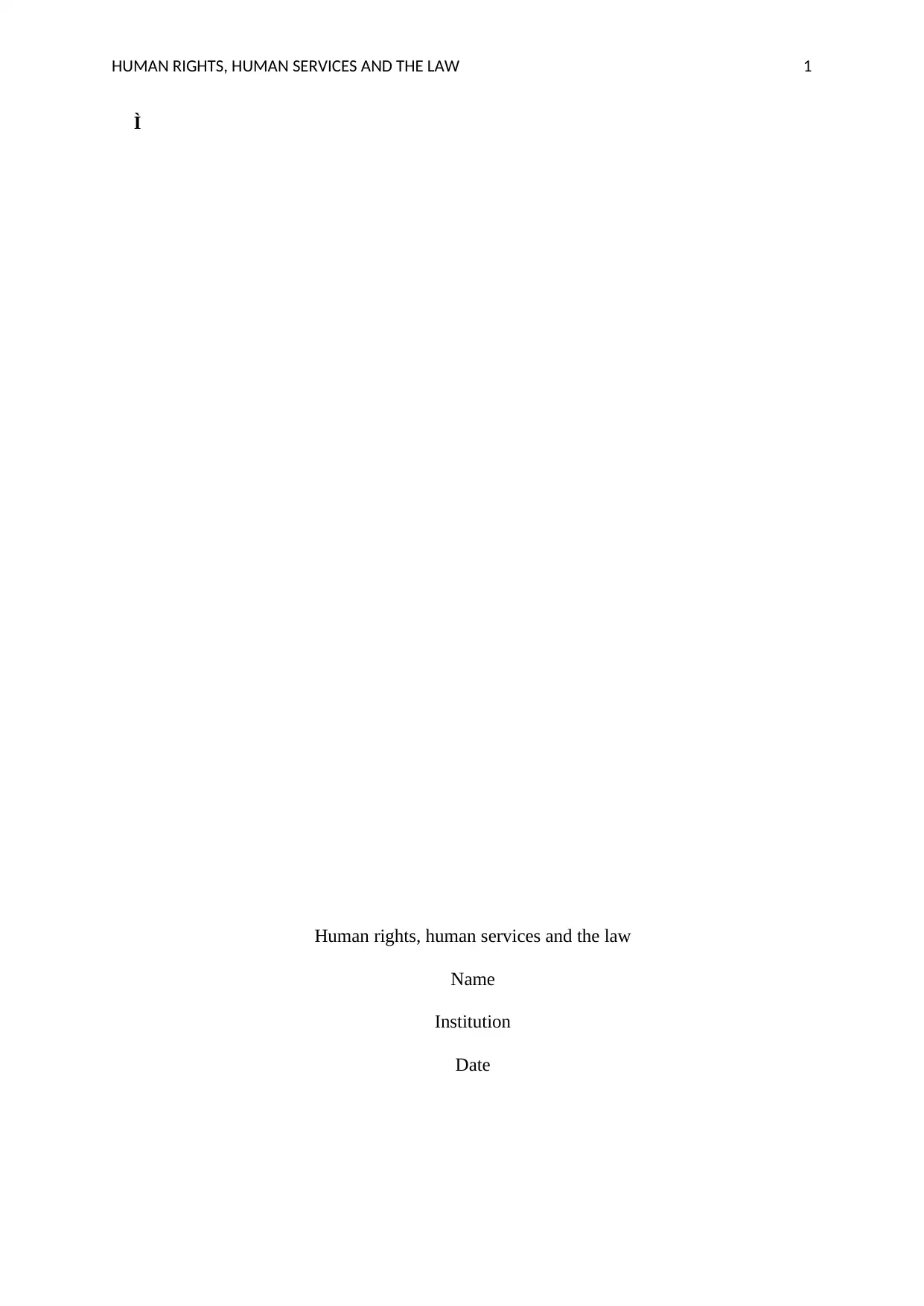
HUMAN RIGHTS, HUMAN SERVICES AND THE LAW 1
Ì
Human rights, human services and the law
Name
Institution
Date
Ì
Human rights, human services and the law
Name
Institution
Date
Paraphrase This Document
Need a fresh take? Get an instant paraphrase of this document with our AI Paraphraser
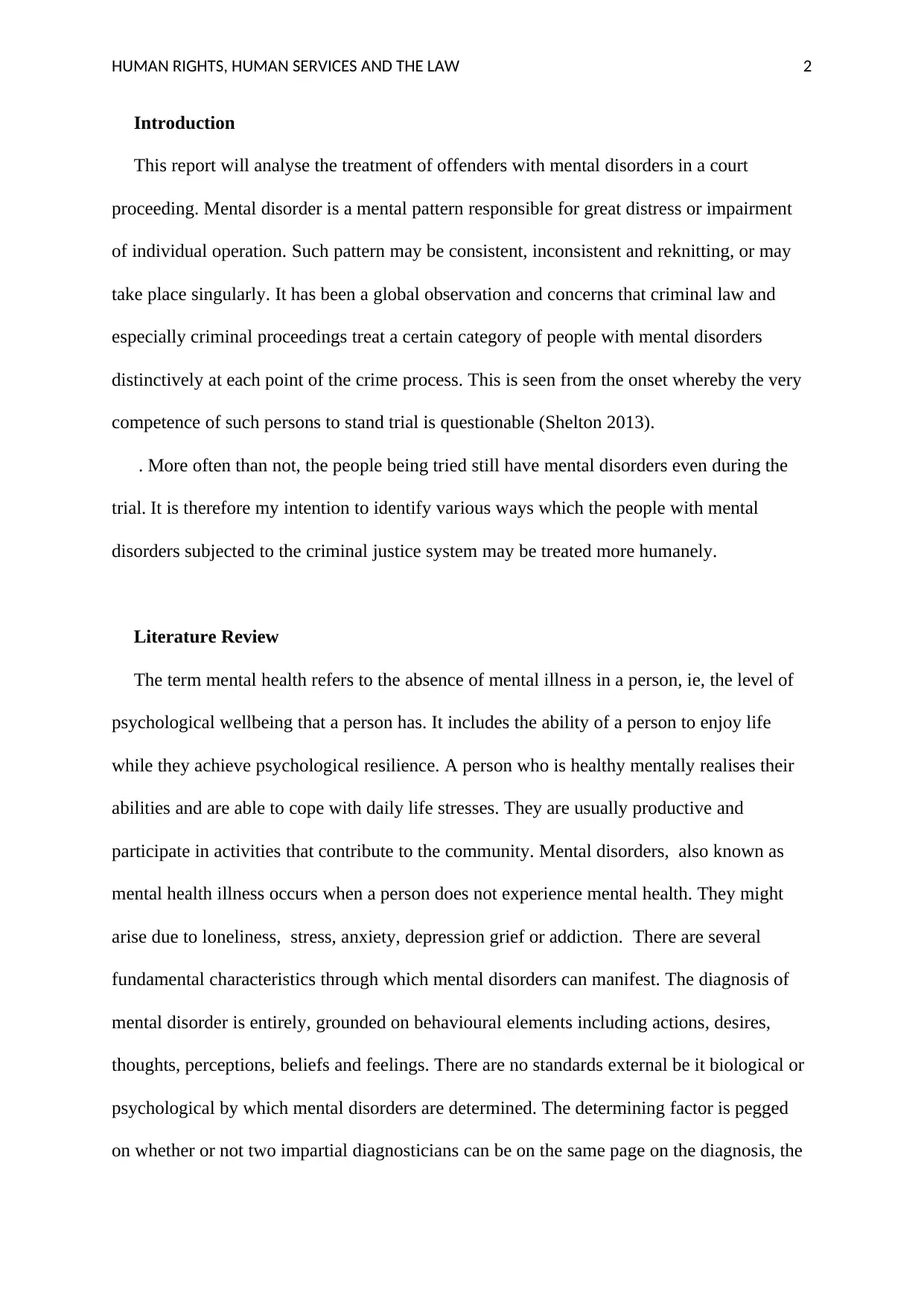
HUMAN RIGHTS, HUMAN SERVICES AND THE LAW 2
Introduction
This report will analyse the treatment of offenders with mental disorders in a court
proceeding. Mental disorder is a mental pattern responsible for great distress or impairment
of individual operation. Such pattern may be consistent, inconsistent and reknitting, or may
take place singularly. It has been a global observation and concerns that criminal law and
especially criminal proceedings treat a certain category of people with mental disorders
distinctively at each point of the crime process. This is seen from the onset whereby the very
competence of such persons to stand trial is questionable (Shelton 2013).
. More often than not, the people being tried still have mental disorders even during the
trial. It is therefore my intention to identify various ways which the people with mental
disorders subjected to the criminal justice system may be treated more humanely.
Literature Review
The term mental health refers to the absence of mental illness in a person, ie, the level of
psychological wellbeing that a person has. It includes the ability of a person to enjoy life
while they achieve psychological resilience. A person who is healthy mentally realises their
abilities and are able to cope with daily life stresses. They are usually productive and
participate in activities that contribute to the community. Mental disorders, also known as
mental health illness occurs when a person does not experience mental health. They might
arise due to loneliness, stress, anxiety, depression grief or addiction. There are several
fundamental characteristics through which mental disorders can manifest. The diagnosis of
mental disorder is entirely, grounded on behavioural elements including actions, desires,
thoughts, perceptions, beliefs and feelings. There are no standards external be it biological or
psychological by which mental disorders are determined. The determining factor is pegged
on whether or not two impartial diagnosticians can be on the same page on the diagnosis, the
Introduction
This report will analyse the treatment of offenders with mental disorders in a court
proceeding. Mental disorder is a mental pattern responsible for great distress or impairment
of individual operation. Such pattern may be consistent, inconsistent and reknitting, or may
take place singularly. It has been a global observation and concerns that criminal law and
especially criminal proceedings treat a certain category of people with mental disorders
distinctively at each point of the crime process. This is seen from the onset whereby the very
competence of such persons to stand trial is questionable (Shelton 2013).
. More often than not, the people being tried still have mental disorders even during the
trial. It is therefore my intention to identify various ways which the people with mental
disorders subjected to the criminal justice system may be treated more humanely.
Literature Review
The term mental health refers to the absence of mental illness in a person, ie, the level of
psychological wellbeing that a person has. It includes the ability of a person to enjoy life
while they achieve psychological resilience. A person who is healthy mentally realises their
abilities and are able to cope with daily life stresses. They are usually productive and
participate in activities that contribute to the community. Mental disorders, also known as
mental health illness occurs when a person does not experience mental health. They might
arise due to loneliness, stress, anxiety, depression grief or addiction. There are several
fundamental characteristics through which mental disorders can manifest. The diagnosis of
mental disorder is entirely, grounded on behavioural elements including actions, desires,
thoughts, perceptions, beliefs and feelings. There are no standards external be it biological or
psychological by which mental disorders are determined. The determining factor is pegged
on whether or not two impartial diagnosticians can be on the same page on the diagnosis, the
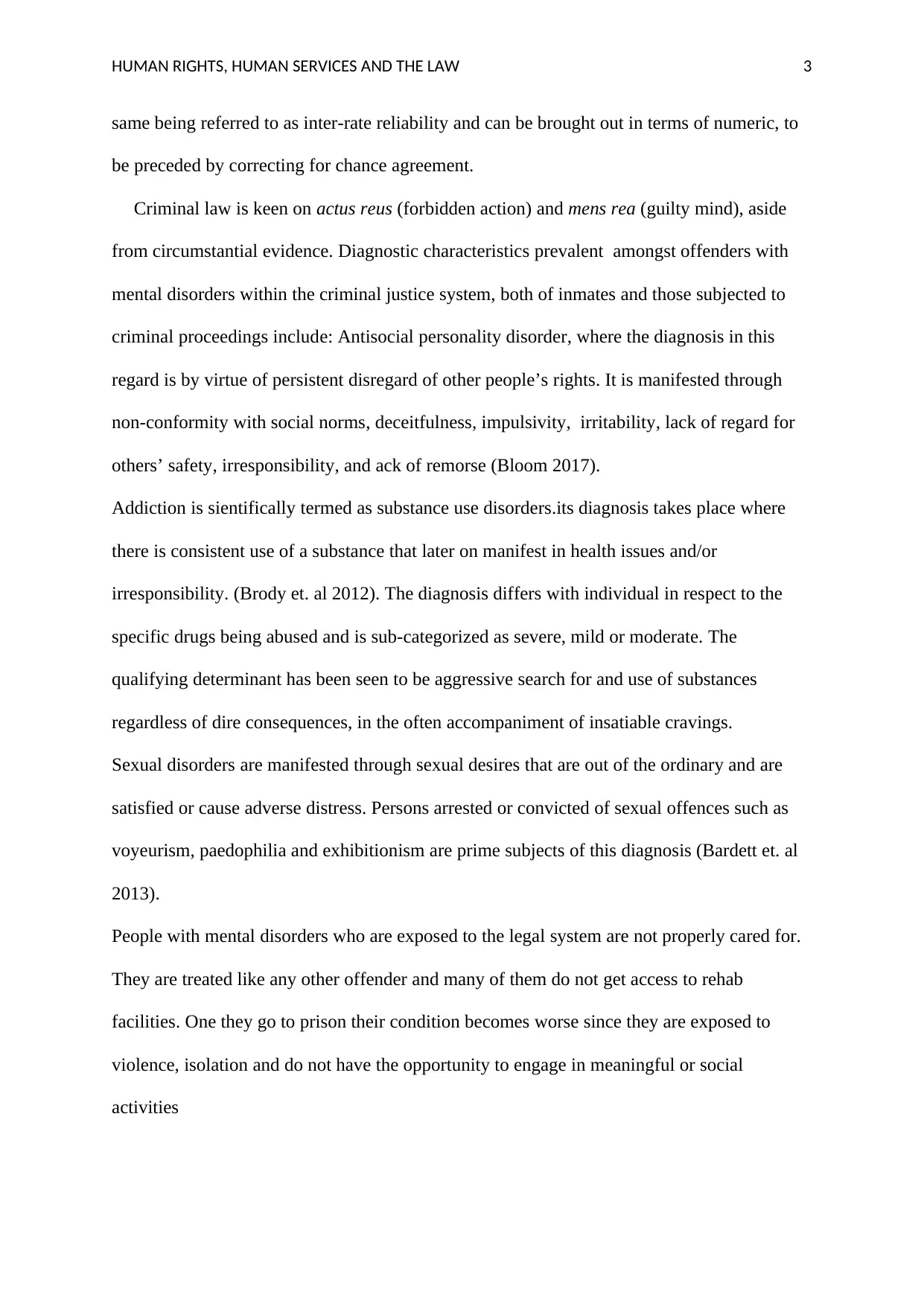
HUMAN RIGHTS, HUMAN SERVICES AND THE LAW 3
same being referred to as inter-rate reliability and can be brought out in terms of numeric, to
be preceded by correcting for chance agreement.
Criminal law is keen on actus reus (forbidden action) and mens rea (guilty mind), aside
from circumstantial evidence. Diagnostic characteristics prevalent amongst offenders with
mental disorders within the criminal justice system, both of inmates and those subjected to
criminal proceedings include: Antisocial personality disorder, where the diagnosis in this
regard is by virtue of persistent disregard of other people’s rights. It is manifested through
non-conformity with social norms, deceitfulness, impulsivity, irritability, lack of regard for
others’ safety, irresponsibility, and ack of remorse (Bloom 2017).
Addiction is sientifically termed as substance use disorders.its diagnosis takes place where
there is consistent use of a substance that later on manifest in health issues and/or
irresponsibility. (Brody et. al 2012). The diagnosis differs with individual in respect to the
specific drugs being abused and is sub-categorized as severe, mild or moderate. The
qualifying determinant has been seen to be aggressive search for and use of substances
regardless of dire consequences, in the often accompaniment of insatiable cravings.
Sexual disorders are manifested through sexual desires that are out of the ordinary and are
satisfied or cause adverse distress. Persons arrested or convicted of sexual offences such as
voyeurism, paedophilia and exhibitionism are prime subjects of this diagnosis (Bardett et. al
2013).
People with mental disorders who are exposed to the legal system are not properly cared for.
They are treated like any other offender and many of them do not get access to rehab
facilities. One they go to prison their condition becomes worse since they are exposed to
violence, isolation and do not have the opportunity to engage in meaningful or social
activities
same being referred to as inter-rate reliability and can be brought out in terms of numeric, to
be preceded by correcting for chance agreement.
Criminal law is keen on actus reus (forbidden action) and mens rea (guilty mind), aside
from circumstantial evidence. Diagnostic characteristics prevalent amongst offenders with
mental disorders within the criminal justice system, both of inmates and those subjected to
criminal proceedings include: Antisocial personality disorder, where the diagnosis in this
regard is by virtue of persistent disregard of other people’s rights. It is manifested through
non-conformity with social norms, deceitfulness, impulsivity, irritability, lack of regard for
others’ safety, irresponsibility, and ack of remorse (Bloom 2017).
Addiction is sientifically termed as substance use disorders.its diagnosis takes place where
there is consistent use of a substance that later on manifest in health issues and/or
irresponsibility. (Brody et. al 2012). The diagnosis differs with individual in respect to the
specific drugs being abused and is sub-categorized as severe, mild or moderate. The
qualifying determinant has been seen to be aggressive search for and use of substances
regardless of dire consequences, in the often accompaniment of insatiable cravings.
Sexual disorders are manifested through sexual desires that are out of the ordinary and are
satisfied or cause adverse distress. Persons arrested or convicted of sexual offences such as
voyeurism, paedophilia and exhibitionism are prime subjects of this diagnosis (Bardett et. al
2013).
People with mental disorders who are exposed to the legal system are not properly cared for.
They are treated like any other offender and many of them do not get access to rehab
facilities. One they go to prison their condition becomes worse since they are exposed to
violence, isolation and do not have the opportunity to engage in meaningful or social
activities
⊘ This is a preview!⊘
Do you want full access?
Subscribe today to unlock all pages.

Trusted by 1+ million students worldwide
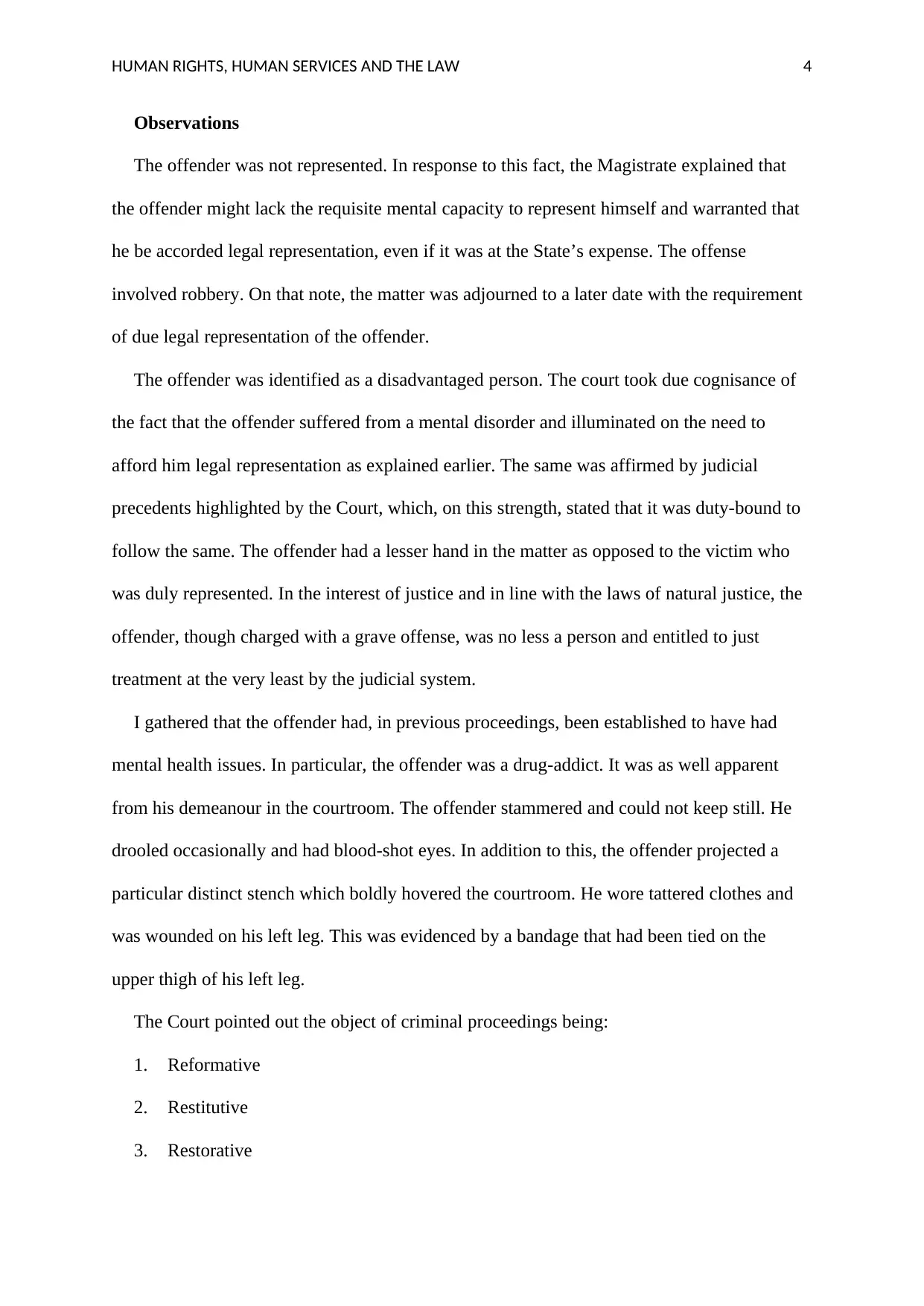
HUMAN RIGHTS, HUMAN SERVICES AND THE LAW 4
Observations
The offender was not represented. In response to this fact, the Magistrate explained that
the offender might lack the requisite mental capacity to represent himself and warranted that
he be accorded legal representation, even if it was at the State’s expense. The offense
involved robbery. On that note, the matter was adjourned to a later date with the requirement
of due legal representation of the offender.
The offender was identified as a disadvantaged person. The court took due cognisance of
the fact that the offender suffered from a mental disorder and illuminated on the need to
afford him legal representation as explained earlier. The same was affirmed by judicial
precedents highlighted by the Court, which, on this strength, stated that it was duty-bound to
follow the same. The offender had a lesser hand in the matter as opposed to the victim who
was duly represented. In the interest of justice and in line with the laws of natural justice, the
offender, though charged with a grave offense, was no less a person and entitled to just
treatment at the very least by the judicial system.
I gathered that the offender had, in previous proceedings, been established to have had
mental health issues. In particular, the offender was a drug-addict. It was as well apparent
from his demeanour in the courtroom. The offender stammered and could not keep still. He
drooled occasionally and had blood-shot eyes. In addition to this, the offender projected a
particular distinct stench which boldly hovered the courtroom. He wore tattered clothes and
was wounded on his left leg. This was evidenced by a bandage that had been tied on the
upper thigh of his left leg.
The Court pointed out the object of criminal proceedings being:
1. Reformative
2. Restitutive
3. Restorative
Observations
The offender was not represented. In response to this fact, the Magistrate explained that
the offender might lack the requisite mental capacity to represent himself and warranted that
he be accorded legal representation, even if it was at the State’s expense. The offense
involved robbery. On that note, the matter was adjourned to a later date with the requirement
of due legal representation of the offender.
The offender was identified as a disadvantaged person. The court took due cognisance of
the fact that the offender suffered from a mental disorder and illuminated on the need to
afford him legal representation as explained earlier. The same was affirmed by judicial
precedents highlighted by the Court, which, on this strength, stated that it was duty-bound to
follow the same. The offender had a lesser hand in the matter as opposed to the victim who
was duly represented. In the interest of justice and in line with the laws of natural justice, the
offender, though charged with a grave offense, was no less a person and entitled to just
treatment at the very least by the judicial system.
I gathered that the offender had, in previous proceedings, been established to have had
mental health issues. In particular, the offender was a drug-addict. It was as well apparent
from his demeanour in the courtroom. The offender stammered and could not keep still. He
drooled occasionally and had blood-shot eyes. In addition to this, the offender projected a
particular distinct stench which boldly hovered the courtroom. He wore tattered clothes and
was wounded on his left leg. This was evidenced by a bandage that had been tied on the
upper thigh of his left leg.
The Court pointed out the object of criminal proceedings being:
1. Reformative
2. Restitutive
3. Restorative
Paraphrase This Document
Need a fresh take? Get an instant paraphrase of this document with our AI Paraphraser
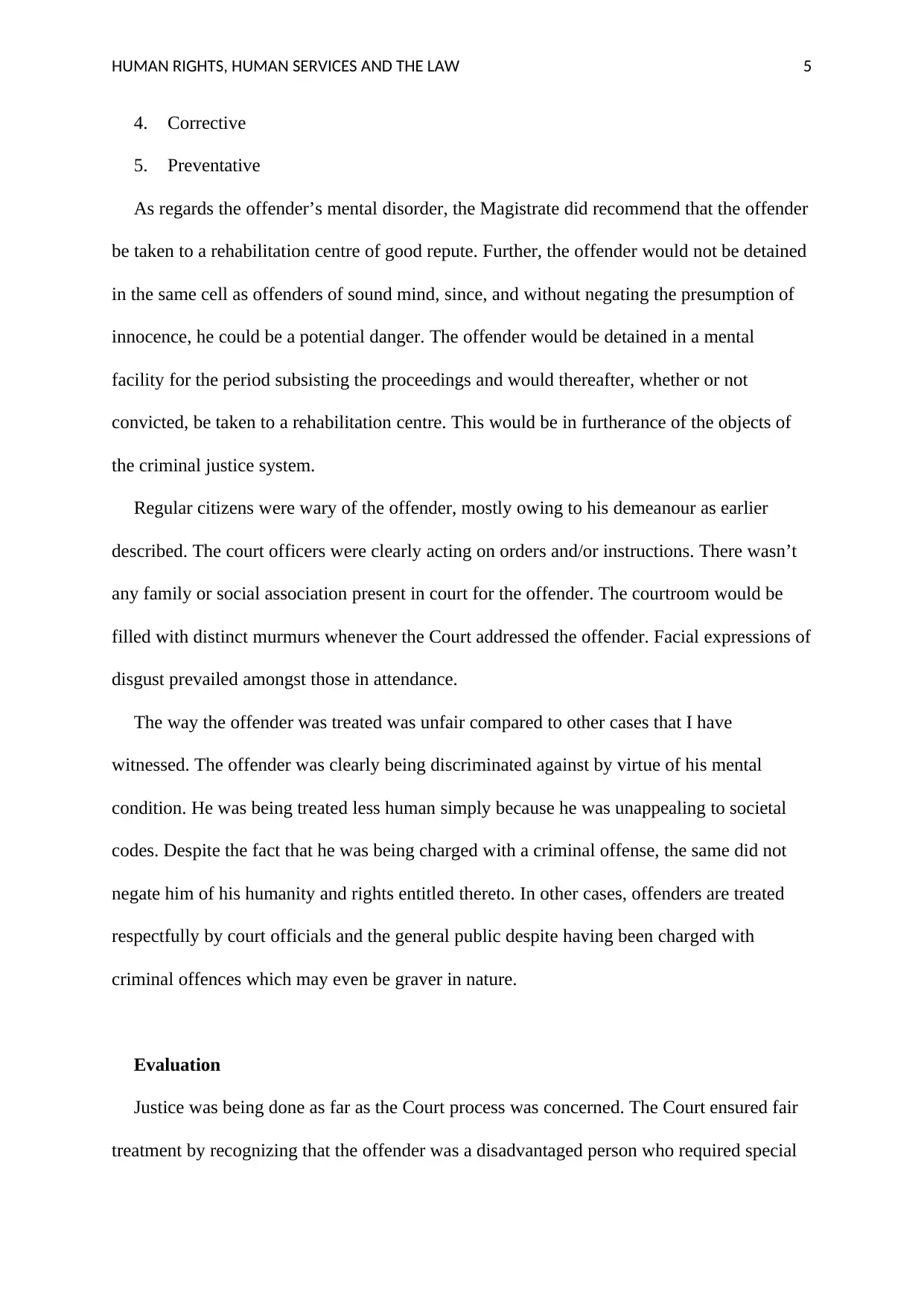
HUMAN RIGHTS, HUMAN SERVICES AND THE LAW 5
4. Corrective
5. Preventative
As regards the offender’s mental disorder, the Magistrate did recommend that the offender
be taken to a rehabilitation centre of good repute. Further, the offender would not be detained
in the same cell as offenders of sound mind, since, and without negating the presumption of
innocence, he could be a potential danger. The offender would be detained in a mental
facility for the period subsisting the proceedings and would thereafter, whether or not
convicted, be taken to a rehabilitation centre. This would be in furtherance of the objects of
the criminal justice system.
Regular citizens were wary of the offender, mostly owing to his demeanour as earlier
described. The court officers were clearly acting on orders and/or instructions. There wasn’t
any family or social association present in court for the offender. The courtroom would be
filled with distinct murmurs whenever the Court addressed the offender. Facial expressions of
disgust prevailed amongst those in attendance.
The way the offender was treated was unfair compared to other cases that I have
witnessed. The offender was clearly being discriminated against by virtue of his mental
condition. He was being treated less human simply because he was unappealing to societal
codes. Despite the fact that he was being charged with a criminal offense, the same did not
negate him of his humanity and rights entitled thereto. In other cases, offenders are treated
respectfully by court officials and the general public despite having been charged with
criminal offences which may even be graver in nature.
Evaluation
Justice was being done as far as the Court process was concerned. The Court ensured fair
treatment by recognizing that the offender was a disadvantaged person who required special
4. Corrective
5. Preventative
As regards the offender’s mental disorder, the Magistrate did recommend that the offender
be taken to a rehabilitation centre of good repute. Further, the offender would not be detained
in the same cell as offenders of sound mind, since, and without negating the presumption of
innocence, he could be a potential danger. The offender would be detained in a mental
facility for the period subsisting the proceedings and would thereafter, whether or not
convicted, be taken to a rehabilitation centre. This would be in furtherance of the objects of
the criminal justice system.
Regular citizens were wary of the offender, mostly owing to his demeanour as earlier
described. The court officers were clearly acting on orders and/or instructions. There wasn’t
any family or social association present in court for the offender. The courtroom would be
filled with distinct murmurs whenever the Court addressed the offender. Facial expressions of
disgust prevailed amongst those in attendance.
The way the offender was treated was unfair compared to other cases that I have
witnessed. The offender was clearly being discriminated against by virtue of his mental
condition. He was being treated less human simply because he was unappealing to societal
codes. Despite the fact that he was being charged with a criminal offense, the same did not
negate him of his humanity and rights entitled thereto. In other cases, offenders are treated
respectfully by court officials and the general public despite having been charged with
criminal offences which may even be graver in nature.
Evaluation
Justice was being done as far as the Court process was concerned. The Court ensured fair
treatment by recognizing that the offender was a disadvantaged person who required special
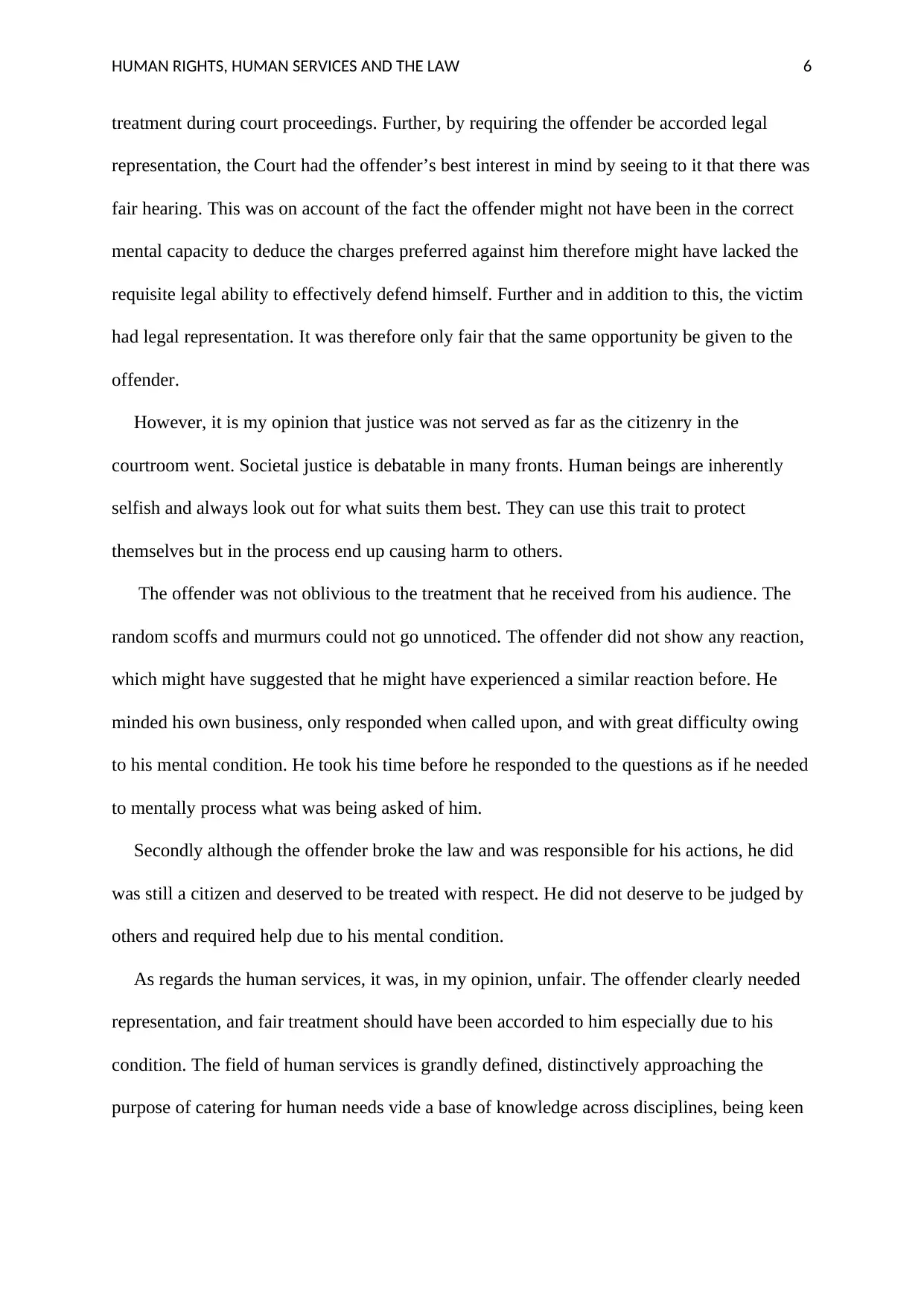
HUMAN RIGHTS, HUMAN SERVICES AND THE LAW 6
treatment during court proceedings. Further, by requiring the offender be accorded legal
representation, the Court had the offender’s best interest in mind by seeing to it that there was
fair hearing. This was on account of the fact the offender might not have been in the correct
mental capacity to deduce the charges preferred against him therefore might have lacked the
requisite legal ability to effectively defend himself. Further and in addition to this, the victim
had legal representation. It was therefore only fair that the same opportunity be given to the
offender.
However, it is my opinion that justice was not served as far as the citizenry in the
courtroom went. Societal justice is debatable in many fronts. Human beings are inherently
selfish and always look out for what suits them best. They can use this trait to protect
themselves but in the process end up causing harm to others.
The offender was not oblivious to the treatment that he received from his audience. The
random scoffs and murmurs could not go unnoticed. The offender did not show any reaction,
which might have suggested that he might have experienced a similar reaction before. He
minded his own business, only responded when called upon, and with great difficulty owing
to his mental condition. He took his time before he responded to the questions as if he needed
to mentally process what was being asked of him.
Secondly although the offender broke the law and was responsible for his actions, he did
was still a citizen and deserved to be treated with respect. He did not deserve to be judged by
others and required help due to his mental condition.
As regards the human services, it was, in my opinion, unfair. The offender clearly needed
representation, and fair treatment should have been accorded to him especially due to his
condition. The field of human services is grandly defined, distinctively approaching the
purpose of catering for human needs vide a base of knowledge across disciplines, being keen
treatment during court proceedings. Further, by requiring the offender be accorded legal
representation, the Court had the offender’s best interest in mind by seeing to it that there was
fair hearing. This was on account of the fact the offender might not have been in the correct
mental capacity to deduce the charges preferred against him therefore might have lacked the
requisite legal ability to effectively defend himself. Further and in addition to this, the victim
had legal representation. It was therefore only fair that the same opportunity be given to the
offender.
However, it is my opinion that justice was not served as far as the citizenry in the
courtroom went. Societal justice is debatable in many fronts. Human beings are inherently
selfish and always look out for what suits them best. They can use this trait to protect
themselves but in the process end up causing harm to others.
The offender was not oblivious to the treatment that he received from his audience. The
random scoffs and murmurs could not go unnoticed. The offender did not show any reaction,
which might have suggested that he might have experienced a similar reaction before. He
minded his own business, only responded when called upon, and with great difficulty owing
to his mental condition. He took his time before he responded to the questions as if he needed
to mentally process what was being asked of him.
Secondly although the offender broke the law and was responsible for his actions, he did
was still a citizen and deserved to be treated with respect. He did not deserve to be judged by
others and required help due to his mental condition.
As regards the human services, it was, in my opinion, unfair. The offender clearly needed
representation, and fair treatment should have been accorded to him especially due to his
condition. The field of human services is grandly defined, distinctively approaching the
purpose of catering for human needs vide a base of knowledge across disciplines, being keen
⊘ This is a preview!⊘
Do you want full access?
Subscribe today to unlock all pages.

Trusted by 1+ million students worldwide

HUMAN RIGHTS, HUMAN SERVICES AND THE LAW 7
on equitable treatment of both the offender and victim. They should be committed to
bettering the larger quality of life of disadvantaged people.
First and foremost, I do acknowledge that it was imperative to establish that the offender
suffered from a mental disability. This went a long way in determining the judicial treatment
of the offender as far as criminal proceedings were concerned. Secondly, as was state earlier,
the offender not only lacked legal representation but also lacked any form of social
representation. None of his family or friends was present at the court but the he fact that the
human services was there for the offender was a worthwhile statement, at least for the
offender.
However, the offender that appeared in court was not well mentally. The human services
are mandated to look out for disadvantaged people, in this case, ensure that he had proper
legal representation They ought to have seen to it that the offender would appear in court in a
presentable manner where he was of sound mind and nt under the influence of drugs. This
would most definitely help against the public ridicule by the citizenry in the courtroom.
The human services failed the offender in this case. They should have done better.
Below are some of my recommendations, aside from those already highlighted:
1. The basic human rights such as the right to dignity should be afforded to offenders
with mental disorders
2. Jail and prison mental-health services should be incorporated in the criminal justice
system.
3. Arrested offenders with mental health disorders should be detained in mental health
facilities.
Conclusion
From the above, it is my conclusion that the criminal justice system is not only limited to
judicial processes but encompasses the wider public. There is a dire need to educate and
on equitable treatment of both the offender and victim. They should be committed to
bettering the larger quality of life of disadvantaged people.
First and foremost, I do acknowledge that it was imperative to establish that the offender
suffered from a mental disability. This went a long way in determining the judicial treatment
of the offender as far as criminal proceedings were concerned. Secondly, as was state earlier,
the offender not only lacked legal representation but also lacked any form of social
representation. None of his family or friends was present at the court but the he fact that the
human services was there for the offender was a worthwhile statement, at least for the
offender.
However, the offender that appeared in court was not well mentally. The human services
are mandated to look out for disadvantaged people, in this case, ensure that he had proper
legal representation They ought to have seen to it that the offender would appear in court in a
presentable manner where he was of sound mind and nt under the influence of drugs. This
would most definitely help against the public ridicule by the citizenry in the courtroom.
The human services failed the offender in this case. They should have done better.
Below are some of my recommendations, aside from those already highlighted:
1. The basic human rights such as the right to dignity should be afforded to offenders
with mental disorders
2. Jail and prison mental-health services should be incorporated in the criminal justice
system.
3. Arrested offenders with mental health disorders should be detained in mental health
facilities.
Conclusion
From the above, it is my conclusion that the criminal justice system is not only limited to
judicial processes but encompasses the wider public. There is a dire need to educate and
Paraphrase This Document
Need a fresh take? Get an instant paraphrase of this document with our AI Paraphraser
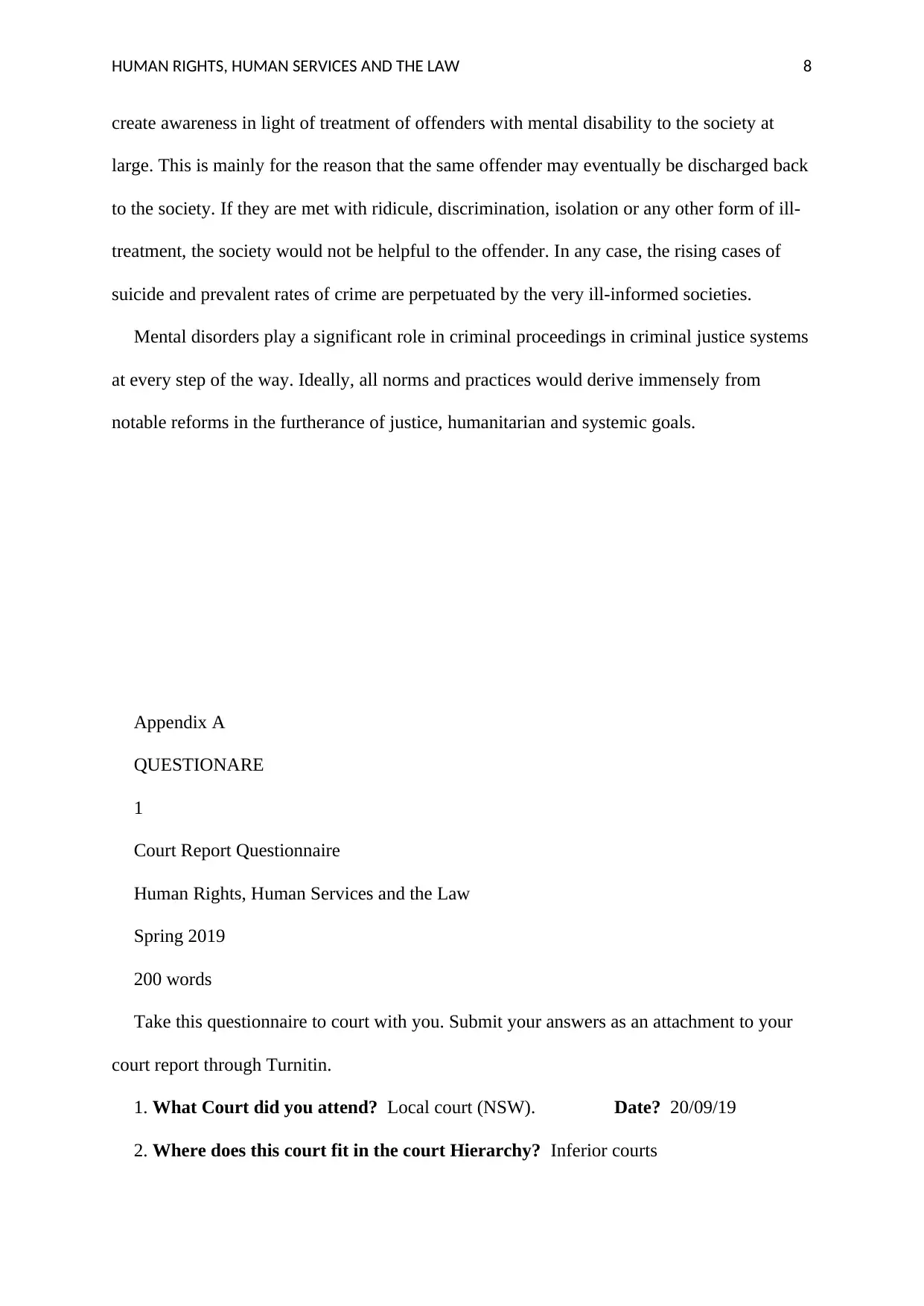
HUMAN RIGHTS, HUMAN SERVICES AND THE LAW 8
create awareness in light of treatment of offenders with mental disability to the society at
large. This is mainly for the reason that the same offender may eventually be discharged back
to the society. If they are met with ridicule, discrimination, isolation or any other form of ill-
treatment, the society would not be helpful to the offender. In any case, the rising cases of
suicide and prevalent rates of crime are perpetuated by the very ill-informed societies.
Mental disorders play a significant role in criminal proceedings in criminal justice systems
at every step of the way. Ideally, all norms and practices would derive immensely from
notable reforms in the furtherance of justice, humanitarian and systemic goals.
Appendix A
QUESTIONARE
1
Court Report Questionnaire
Human Rights, Human Services and the Law
Spring 2019
200 words
Take this questionnaire to court with you. Submit your answers as an attachment to your
court report through Turnitin.
1. What Court did you attend? Local court (NSW). Date? 20/09/19
2. Where does this court fit in the court Hierarchy? Inferior courts
create awareness in light of treatment of offenders with mental disability to the society at
large. This is mainly for the reason that the same offender may eventually be discharged back
to the society. If they are met with ridicule, discrimination, isolation or any other form of ill-
treatment, the society would not be helpful to the offender. In any case, the rising cases of
suicide and prevalent rates of crime are perpetuated by the very ill-informed societies.
Mental disorders play a significant role in criminal proceedings in criminal justice systems
at every step of the way. Ideally, all norms and practices would derive immensely from
notable reforms in the furtherance of justice, humanitarian and systemic goals.
Appendix A
QUESTIONARE
1
Court Report Questionnaire
Human Rights, Human Services and the Law
Spring 2019
200 words
Take this questionnaire to court with you. Submit your answers as an attachment to your
court report through Turnitin.
1. What Court did you attend? Local court (NSW). Date? 20/09/19
2. Where does this court fit in the court Hierarchy? Inferior courts
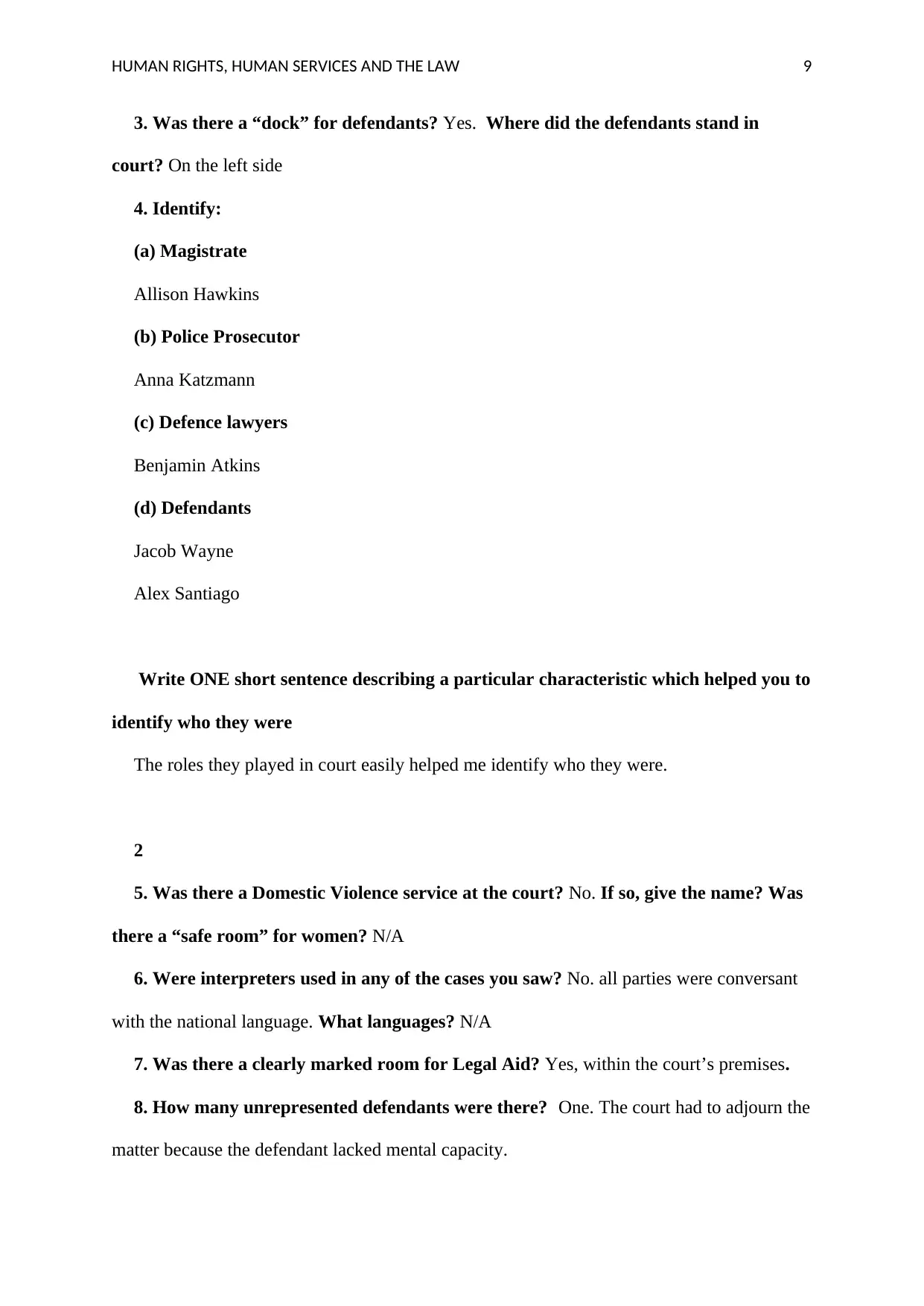
HUMAN RIGHTS, HUMAN SERVICES AND THE LAW 9
3. Was there a “dock” for defendants? Yes. Where did the defendants stand in
court? On the left side
4. Identify:
(a) Magistrate
Allison Hawkins
(b) Police Prosecutor
Anna Katzmann
(c) Defence lawyers
Benjamin Atkins
(d) Defendants
Jacob Wayne
Alex Santiago
Write ONE short sentence describing a particular characteristic which helped you to
identify who they were
The roles they played in court easily helped me identify who they were.
2
5. Was there a Domestic Violence service at the court? No. If so, give the name? Was
there a “safe room” for women? N/A
6. Were interpreters used in any of the cases you saw? No. all parties were conversant
with the national language. What languages? N/A
7. Was there a clearly marked room for Legal Aid? Yes, within the court’s premises.
8. How many unrepresented defendants were there? One. The court had to adjourn the
matter because the defendant lacked mental capacity.
3. Was there a “dock” for defendants? Yes. Where did the defendants stand in
court? On the left side
4. Identify:
(a) Magistrate
Allison Hawkins
(b) Police Prosecutor
Anna Katzmann
(c) Defence lawyers
Benjamin Atkins
(d) Defendants
Jacob Wayne
Alex Santiago
Write ONE short sentence describing a particular characteristic which helped you to
identify who they were
The roles they played in court easily helped me identify who they were.
2
5. Was there a Domestic Violence service at the court? No. If so, give the name? Was
there a “safe room” for women? N/A
6. Were interpreters used in any of the cases you saw? No. all parties were conversant
with the national language. What languages? N/A
7. Was there a clearly marked room for Legal Aid? Yes, within the court’s premises.
8. How many unrepresented defendants were there? One. The court had to adjourn the
matter because the defendant lacked mental capacity.
⊘ This is a preview!⊘
Do you want full access?
Subscribe today to unlock all pages.

Trusted by 1+ million students worldwide
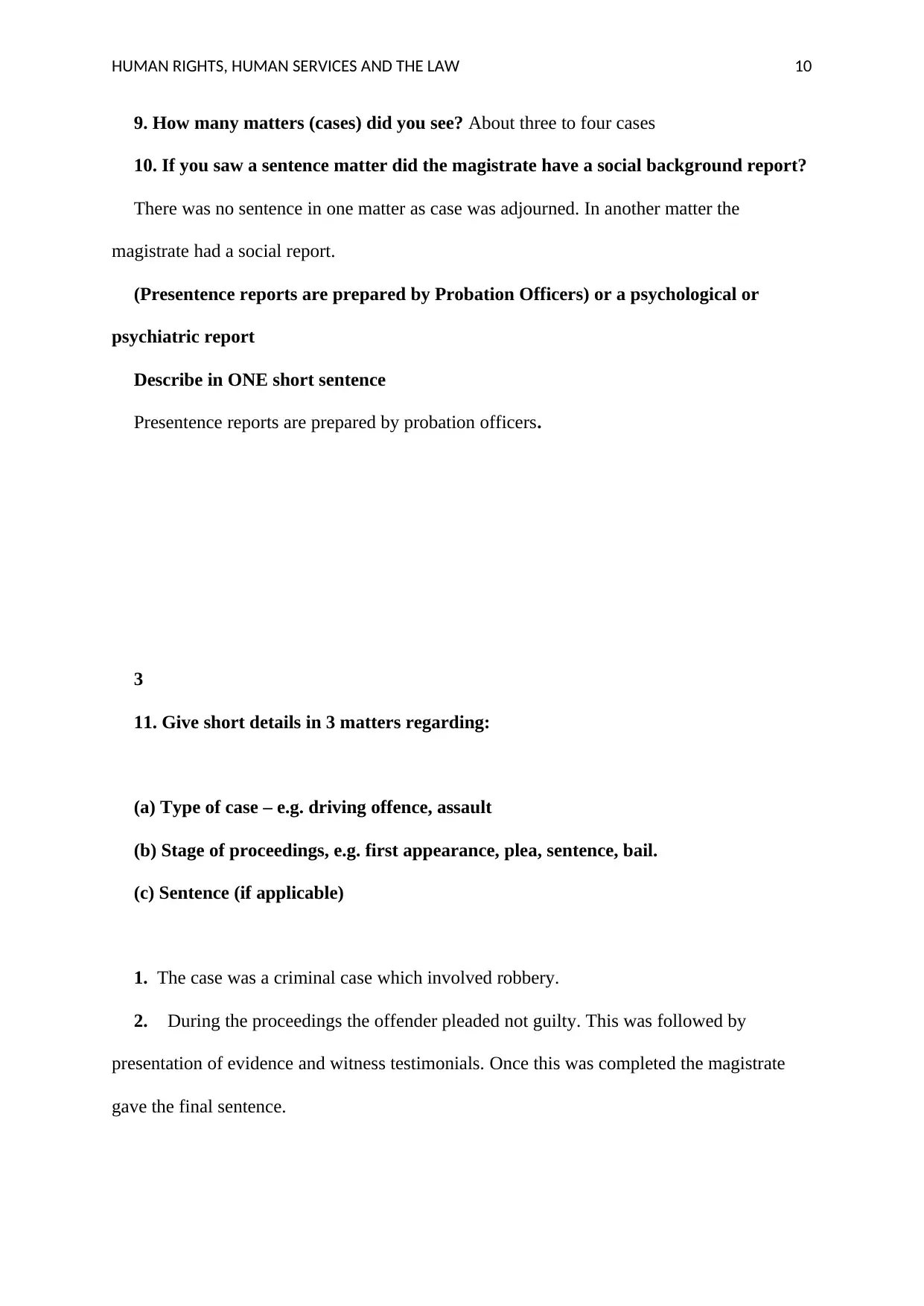
HUMAN RIGHTS, HUMAN SERVICES AND THE LAW 10
9. How many matters (cases) did you see? About three to four cases
10. If you saw a sentence matter did the magistrate have a social background report?
There was no sentence in one matter as case was adjourned. In another matter the
magistrate had a social report.
(Presentence reports are prepared by Probation Officers) or a psychological or
psychiatric report
Describe in ONE short sentence
Presentence reports are prepared by probation officers.
3
11. Give short details in 3 matters regarding:
(a) Type of case – e.g. driving offence, assault
(b) Stage of proceedings, e.g. first appearance, plea, sentence, bail.
(c) Sentence (if applicable)
1. The case was a criminal case which involved robbery.
2. During the proceedings the offender pleaded not guilty. This was followed by
presentation of evidence and witness testimonials. Once this was completed the magistrate
gave the final sentence.
9. How many matters (cases) did you see? About three to four cases
10. If you saw a sentence matter did the magistrate have a social background report?
There was no sentence in one matter as case was adjourned. In another matter the
magistrate had a social report.
(Presentence reports are prepared by Probation Officers) or a psychological or
psychiatric report
Describe in ONE short sentence
Presentence reports are prepared by probation officers.
3
11. Give short details in 3 matters regarding:
(a) Type of case – e.g. driving offence, assault
(b) Stage of proceedings, e.g. first appearance, plea, sentence, bail.
(c) Sentence (if applicable)
1. The case was a criminal case which involved robbery.
2. During the proceedings the offender pleaded not guilty. This was followed by
presentation of evidence and witness testimonials. Once this was completed the magistrate
gave the final sentence.
Paraphrase This Document
Need a fresh take? Get an instant paraphrase of this document with our AI Paraphraser
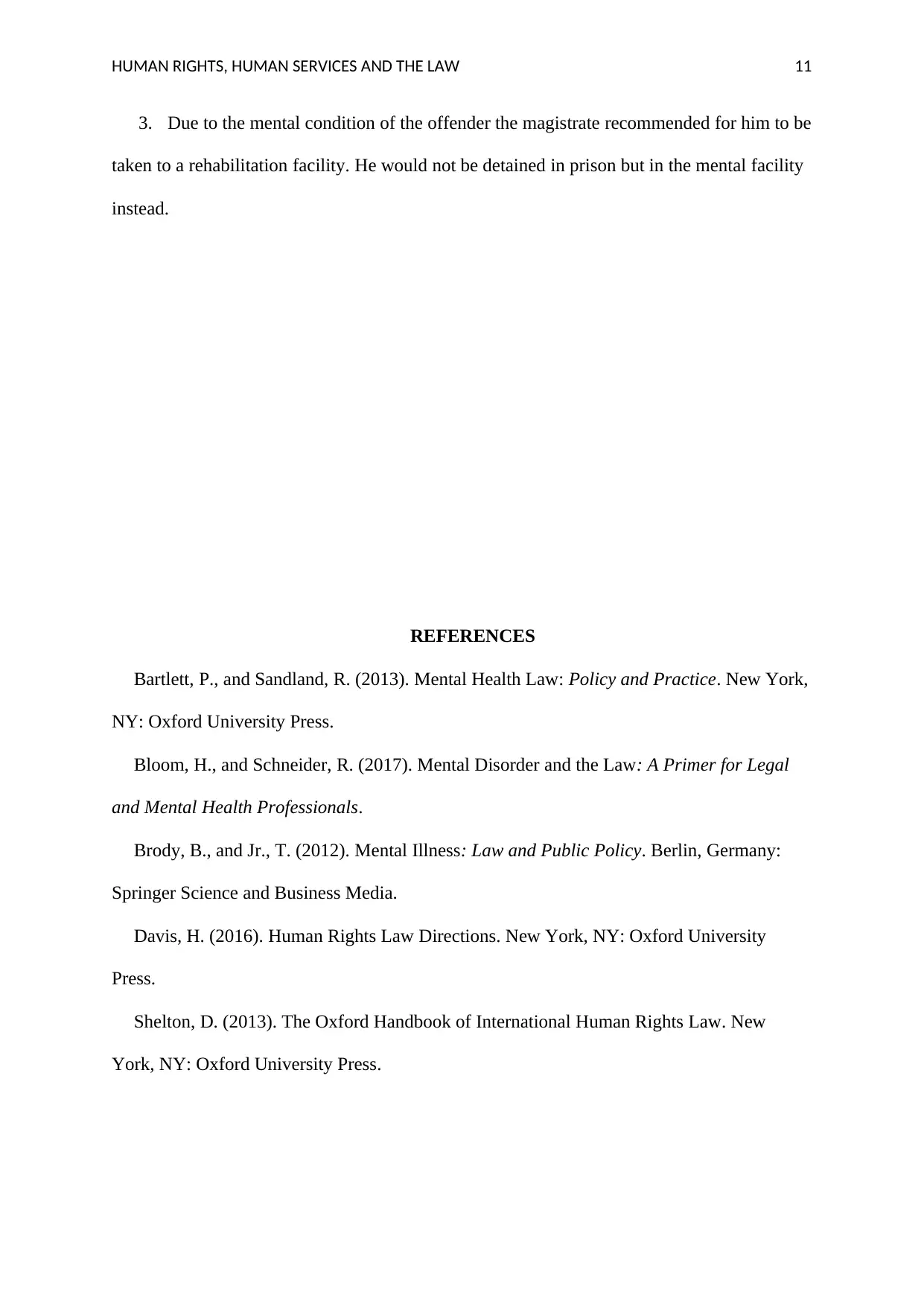
HUMAN RIGHTS, HUMAN SERVICES AND THE LAW 11
3. Due to the mental condition of the offender the magistrate recommended for him to be
taken to a rehabilitation facility. He would not be detained in prison but in the mental facility
instead.
REFERENCES
Bartlett, P., and Sandland, R. (2013). Mental Health Law: Policy and Practice. New York,
NY: Oxford University Press.
Bloom, H., and Schneider, R. (2017). Mental Disorder and the Law: A Primer for Legal
and Mental Health Professionals.
Brody, B., and Jr., T. (2012). Mental Illness: Law and Public Policy. Berlin, Germany:
Springer Science and Business Media.
Davis, H. (2016). Human Rights Law Directions. New York, NY: Oxford University
Press.
Shelton, D. (2013). The Oxford Handbook of International Human Rights Law. New
York, NY: Oxford University Press.
3. Due to the mental condition of the offender the magistrate recommended for him to be
taken to a rehabilitation facility. He would not be detained in prison but in the mental facility
instead.
REFERENCES
Bartlett, P., and Sandland, R. (2013). Mental Health Law: Policy and Practice. New York,
NY: Oxford University Press.
Bloom, H., and Schneider, R. (2017). Mental Disorder and the Law: A Primer for Legal
and Mental Health Professionals.
Brody, B., and Jr., T. (2012). Mental Illness: Law and Public Policy. Berlin, Germany:
Springer Science and Business Media.
Davis, H. (2016). Human Rights Law Directions. New York, NY: Oxford University
Press.
Shelton, D. (2013). The Oxford Handbook of International Human Rights Law. New
York, NY: Oxford University Press.
1 out of 11
Related Documents
Your All-in-One AI-Powered Toolkit for Academic Success.
+13062052269
info@desklib.com
Available 24*7 on WhatsApp / Email
![[object Object]](/_next/static/media/star-bottom.7253800d.svg)
Unlock your academic potential
Copyright © 2020–2025 A2Z Services. All Rights Reserved. Developed and managed by ZUCOL.





